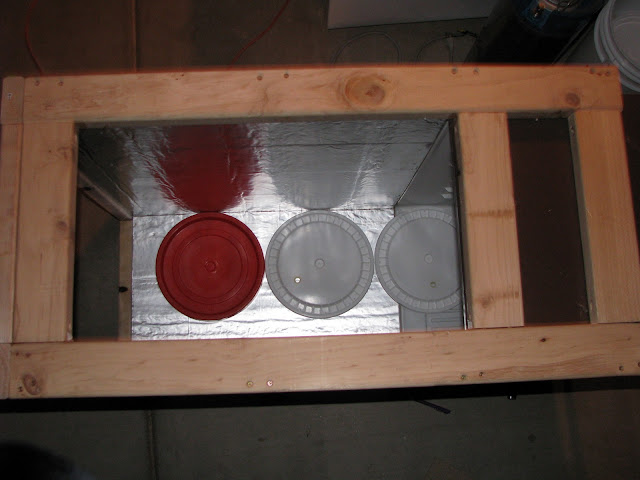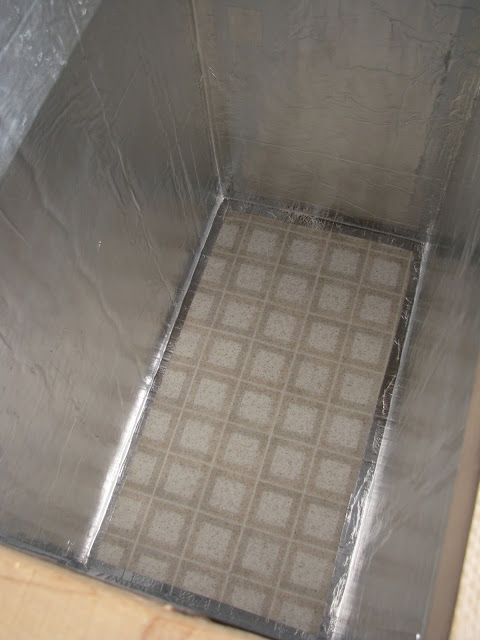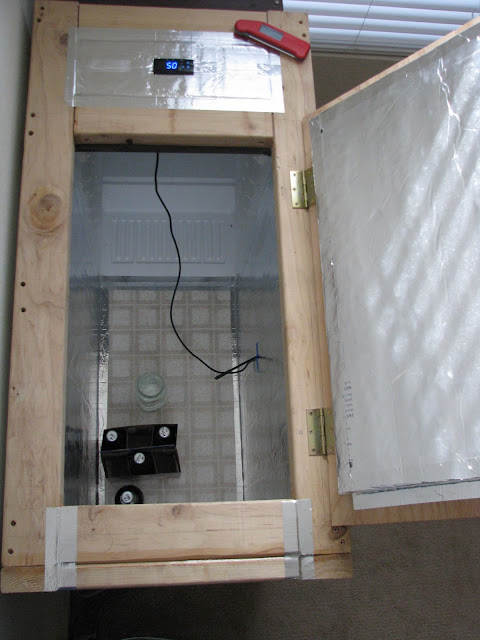not too much had been going on. I have brewed a few beers since. A whiskey barrel stout, and a coffee stout that turned out incredibly well, and was very well received by all who had the opportunity to sample it.
This post is a bump to keep the blog alive. A few weeks ago I made my second ever online purchase with @hopsdirect. They continue to be my favorite online hops supplier. I ordered 5 pounds, 1 pound each of pellet Magnum, Columbus, Bravo, and leaf Citra and Belma.
This past weekend I brewed up about 12 gallons of what I have dubbed Sputum IPA in lieu of my recent recovery of pneumonia. Brewday went off without a hitch, pre boil gravity was 1 point under at 1.059, but OG ended up a point over at 1.071. I split the brew into two 6 gallon batches, and innoculsted one with @WhiteLabs WLP001, and the other with WLP007.
Today is the 4th day of fermentation, and when I checked yesterday, the WLP001 was still blowing of a little while the WLP007 had subsided. Hoping to switch to airlocks today or tomorrow.
The plan is a 21 day primary, cold crash at 32F for 3 days rack to secondary, dry hop and allow the beer to warm to about 65-70F for 7 days and then cold crash a second time before racking to kegs and carbing.
I plan to dry hop one with Citra and Columbus, and I think the other will be strictly Belma which is @HopsDirect very own pedigree of hop. I have heard mixed reviews on its place for bittering, flavoring, and dry hop additions, so I think I'll experiment with it as a sine dry hop and see what my perception is of its flavor. Worse comes to worst, I can throw some Citra in the keg to compensate if the flavor doesn't bode well.
| Sputum |
| American IPA |
| Type: All Grain | Date: 12/15/2012 | |||||||||||||||||||||||||||||||||||||||||||||||||||||||||||||||||||||||||||
| Batch Size (fermenter): 11.00 gal | Brewer: Tyson | |||||||||||||||||||||||||||||||||||||||||||||||||||||||||||||||||||||||||||
| Boil Size: 13.81 gal | Asst Brewer: | |||||||||||||||||||||||||||||||||||||||||||||||||||||||||||||||||||||||||||
| Boil Time: 60 min | Equipment: My Equipment (15gal Kettle & 52qt Coleman Xtreme MLT) | |||||||||||||||||||||||||||||||||||||||||||||||||||||||||||||||||||||||||||
| End of Boil Volume 12.48 gal | Brewhouse Efficiency: 79.00 % | |||||||||||||||||||||||||||||||||||||||||||||||||||||||||||||||||||||||||||
| Final Bottling Volume: 11.00 gal | Est Mash Efficiency 86.2 % | |||||||||||||||||||||||||||||||||||||||||||||||||||||||||||||||||||||||||||
| Fermentation: Ale, Two Stage | Taste Rating(out of 50): 30.0 | |||||||||||||||||||||||||||||||||||||||||||||||||||||||||||||||||||||||||||
| Taste Notes: ~ | ||||||||||||||||||||||||||||||||||||||||||||||||||||||||||||||||||||||||||||
|
Ingredients
| ||||||||||||||||||||||||||||||||||||||||||||||||||||||||||||||||||||||||||||
| ||||||||||||||||||||||||||||||||||||||||||||||||||||||||||||||||||||||||||||
|
Beer
Profile
| ||||||||||||||||||||||||||||||||||||||||||||||||||||||||||||||||||||||||||||
| Est Original Gravity: 1.069 SG | Measured Original Gravity: 1.071 SG | |||||||||||||||||||||||||||||||||||||||||||||||||||||||||||||||||||||||||||
| Est Final Gravity: 1.014 SG | Measured Final Gravity: 1.012 SG | |||||||||||||||||||||||||||||||||||||||||||||||||||||||||||||||||||||||||||
| Estimated Alcohol by Vol: 7.2 % | Actual Alcohol by Vol: 7.8 % | |||||||||||||||||||||||||||||||||||||||||||||||||||||||||||||||||||||||||||
| Bitterness: 90.1 IBUs | Calories: 239.5 kcal/12oz | |||||||||||||||||||||||||||||||||||||||||||||||||||||||||||||||||||||||||||
| Est Color: 6.5 SRM | ||||||||||||||||||||||||||||||||||||||||||||||||||||||||||||||||||||||||||||
|
Mash
Profile
| ||||||||||||||||||||||||||||||||||||||||||||||||||||||||||||||||||||||||||||
| Mash Name: Single Infusion, Light Body, Batch Sparge | Total Grain Weight: 26 lbs 5.3 oz | |||||||||||||||||||||||||||||||||||||||||||||||||||||||||||||||||||||||||||
| Sparge Water: 7.10 gal | Grain Temperature: 72.0 F | |||||||||||||||||||||||||||||||||||||||||||||||||||||||||||||||||||||||||||
| Sparge Temperature: 168.0 F | Tun Temperature: 72.0 F | |||||||||||||||||||||||||||||||||||||||||||||||||||||||||||||||||||||||||||
| Adjust Temp for Equipment: TRUE | Mash PH: 5.30 | |||||||||||||||||||||||||||||||||||||||||||||||||||||||||||||||||||||||||||
| ||||||||||||||||||||||||||||||||||||||||||||||||||||||||||||||||||||||||||||
| Sparge Step: Batch sparge with 3 steps (Drain mash tun, , 3.55gal, 3.55gal) of 168.0 F water | ||||||||||||||||||||||||||||||||||||||||||||||||||||||||||||||||||||||||||||
| Mash Notes: Simple single infusion mash for use with most modern well modified grains (about 95% of the time). | ||||||||||||||||||||||||||||||||||||||||||||||||||||||||||||||||||||||||||||
|
Carbonation and
Storage
| ||||||||||||||||||||||||||||||||||||||||||||||||||||||||||||||||||||||||||||
| Carbonation Type: Bottle | Volumes of CO2: 2.3 | |||||||||||||||||||||||||||||||||||||||||||||||||||||||||||||||||||||||||||
| Pressure/Weight: 244.93 g | Carbonation Used: Bottle with 244.93 g Corn Sugar | |||||||||||||||||||||||||||||||||||||||||||||||||||||||||||||||||||||||||||
| Keg/Bottling Temperature: 70.0 F | Age for: 30.00 days | |||||||||||||||||||||||||||||||||||||||||||||||||||||||||||||||||||||||||||
| Fermentation: Ale, Two Stage | Storage Temperature: 65.0 F | |||||||||||||||||||||||||||||||||||||||||||||||||||||||||||||||||||||||||||
|
Notes
| ||||||||||||||||||||||||||||||||||||||||||||||||||||||||||||||||||||||||||||
| 12/30/12 - gravity check: WLP001 - 1.011 @ 71°F = 1.012, Smellsof tropical fruit, priamrily pineapples. WLP007 - 1.012 @ 71°F = 1.103, Smells of tropical fruit, primarily pineapple, the bitterness seems less harsh than the WLP001. 1/06/2012 - Racked to secondary: WLP001 - 1.010 @ 56.5° = 1.010, Added 2oz of Citra for dry hop, plan to dry hop for ~7 days. WLP007 - 1.012 @ 58.3° = 1.012, Added 2oz of Belma for dry hop, plan to dry hop for ~7 days. | ||||||||||||||||||||||||||||||||||||||||||||||||||||||||||||||||||||||||||||
Additionally, I have a batch of Apfelwein fermenting as well, its a deviation from @EdWort recipe, I don't care for it as dry as his recipe makes it, so I use either US-05 or Notty when I make it, and I cut back on the sugar slightly.
Like I said not a whole lot happening, but things are a brewin'.
Keep tuned for big news coming in the next several months. I know its a cliffhanger right? There will be some big announcements in the not too distant future. Thanks to those of you following, and if you've stumbled here by accident or for a peek please follow.
My posts are sporadic at the moment due to school, but I only have three semesters left, then it will be back to normal (fingers crossed).
I do apologize for the lack of photos in this post I was trying to focus on brewing a great IPA rather than documenting my brewing process and procedures, but photos will come.
Cheers!




















































